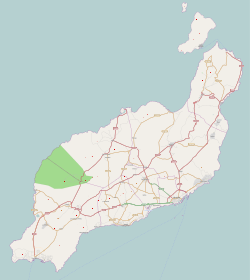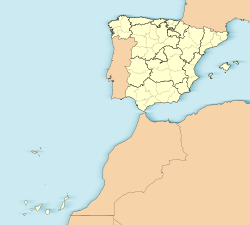| Charco del Palo | |
|---|---|
| Village | |
 | |
  | |
| Coordinates: 29°05′N 13°27′W / 29.083°N 13.450°W / 29.083; -13.450 | |
| Founded by | Gregor Kaiser |
| Population | |
| • Total | 156 |
Charco del Palo is a naturist holiday village on the north-eastern coast of Lanzarote, in the Canary Islands. The village was established around 1970 by the German entrepreneur Gregor Kaiser. In due course, it has developed into a popular naturist resort. It was the first official naturist resort established in the Canaries: nudity is permitted everywhere in the village, and practised universally. Its isolated location, at the end of a dedicated three kilometer long access road, helps to achieve privacy, while the village remains open to all. Visitors are mainly German, British, and Dutch. The village's population increased from 82 in the year 2000 to 229 in 2011, it has subsequently declined to 156 in 2013.
The development was originally named Castillo de Papagayo, but since this causes confusion with the well-known Playa de Papagayo nude beach in the region of Playa Blanca in southern Lanzarote, the name Charco del Palo, which refers to a nearby prominent coastal pool now developed for bathing, has become standard.
Most of the bungalows and apartments are private property; many are being rented out when their owners are not using them. The German nudist travel organization Oböna owns an apartment complex here as well. The village has a few restaurants (Lily's Bar, Jardin Tropical, and Cueva Paloma) and a small supermarket. The terraces of Lily's Bar, Jardin Tropical and Cueva Paloma do allow (and frequently see) naked use.
The village is built on pale sandy soil, but the coast is rocky, with no beaches. However, three sheltered coves have been developed for safe bathing.
Charco del Palo is located near the villages of Mala and Guatiza, both about 3 kilometres (1.9 mi) away, which are served by a regular bus route between the island's capital Arrecife and the north of the island. The surrounding countryside is dominated by fields of prickly pear cactus (known locally as tunera), on which cochineal beetles are reared, and a few small extinct volcano cones.
The village lies mostly within the municipality of Haría, but the border with Teguise cuts through the southern part. All the public land in the area is owned by the original developer, who is responsible for providing public services. However, in recent times, residents have been complaining about neglect of public services such as sewerage, paving, and public lighting, and have been campaigning for the municipalities to assume responsibility for maintenance.
Notes and references
- "Nomenclátor. Relación de unidades poblacionales". Instituto Nacional de Estadística (Spanish Statistical Institute). Retrieved 2012-03-01.
- Corne 2004, pp. 155–.
- Andrews & Quintero 2007, pp. 132–.
- Carlos Inza (18 August 2016). "Refugio de naturistas". Canarias7. Archived from the original on 2016-09-24. Retrieved 2016-09-14.
- "Nomenclátor. Relación de unidades poblacionales". Instituto Nacional de Estadística (Spanish Statistical Institute). Retrieved 2012-03-01.
- "Territorial Information System". Canaries Government. Retrieved 2012-11-19.
- Reisenegger 2006, pp. 49–.
- "Los socialistas de Haría y Teguise se comprometen a equiparar en servicios al Charco del Palo (The socialists of Haría and Teguise promise to investigate services at Charco del Palo)". Spanish Socialist Workers' Party, Socialistas de Lanzarote. 23 February 2011. Archived from the original on 13 March 2013. Retrieved 2012-03-11.
- "Las víctimas de los desmanes urbanísticos (The victims of development abuses)". La Voz de Lanzarote. 22 July 2011. Archived from the original on 2013-03-17.
- Ruth Gabilondo (23 July 2011). "El Charco del Palo muestra sus vergüenzas (Charco del Palo shows its shame)". La Voz de Lanzarote. Archived from the original on 2012-01-14.
- Kraeling, Werner, ed. (2009). Charco del Palo: Das Bilderbuch. Castillo del Papagayo SL.
{{cite book}}: CS1 maint: location missing publisher (link) - Andrews, Sarah; Quintero, Josephine (2007). Canary Islands. Lonely Planet. ISBN 978-1-74104-595-6.
- Corne, Lucy (2004). Canary Islands. Bradt Travel Guides. ISBN 978-1-84162-108-1.
- Reisenegger, Verónica (2006). ANWB Extra - Lanzarote (in Dutch). ANWB Media - Boeken & Gidsen. ISBN 978-90-18-01992-1.
Further reading
- Chinea, E; Batista, C; Mesa, R.; Guerra, J.A.; Rodríguez-Rodríguez, A. (2011). "Estudio de Especies Pascícolas de Lanzarote en su Hábitat. I Características Edafo-Climáticas" (PDF). Pastos, paisajes culturales entre tradición y nuevos paradigmas del siglo (in Spanish). XXI: 79. Archived from the original (PDF) on 2012-12-02. Retrieved 2014-10-06.